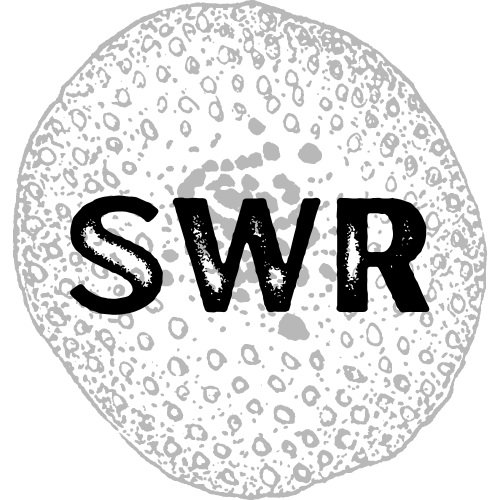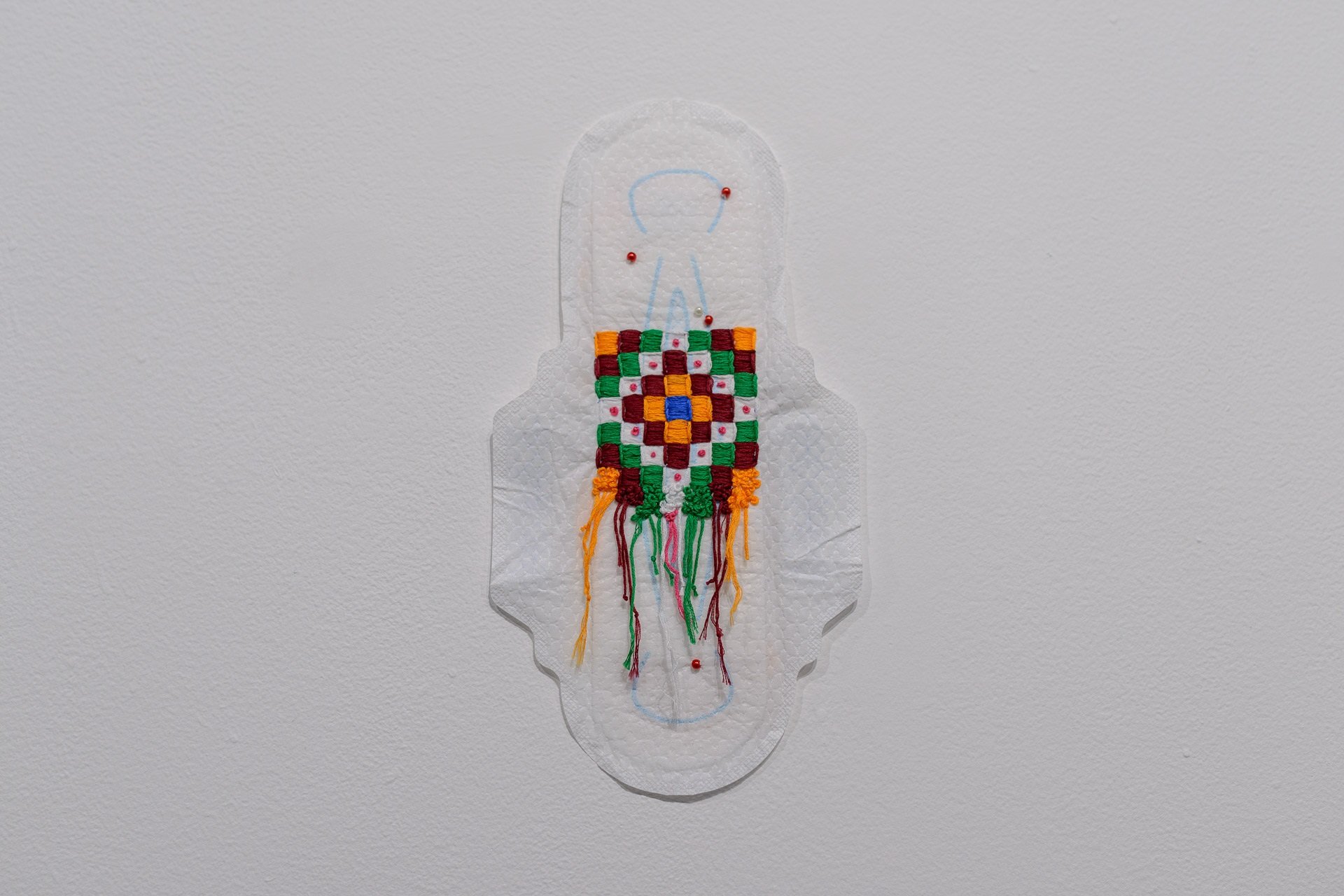Published in Visual Arts News
As a newcomer to Canada from Iran, Nasim Makaremi Nia has been finding a place for herself as a Newfoundland and Labrador artist.
Her work brings together painting, collage, drawing, embroidery and found objects to examine the relationship of women to their bodies within her own cultural foci. She graduated with an MSc in solid-state Physics and is currently an MFA candidate at Grenfell Campus, Memorial University of Newfoundland and Labrador.
Her recent participation in residencies at Eastern Edge and St. Michael’s Printshop have led her to explore her own relationship with place and present works that speak to topics of gender discrimination and body taboo from a global perspective. Makaremi’s work is an expansive process of weaving, of hiding, revealing and threading-through. Found objects that peek out from behind one another, images are just perceptible beneath cracking oil paint, and women’s bodies are concealed in our more-than-human counterparts. Her works reference crystalline structures and the mathematics of sacred geometry found in both Islamic architecture and the natural world. She creates layers so gently and thoughtfully peeled back to invite us in, but not too much, to reveal a mysterious dreamspace of possibility.
Her rich and intricate mixed media works have been bringing her some well-deserved accolades as the newest recipient of VANL-CARFAC’s Emerging Artist Award. We sat down together to discuss Makaremi’s work, our mutual interest in acceptability, politics of the body, our experiences of being transplants to Canada, and the similarities and divergences of the Islamic and Jewish feminisms that we both carry.
Sally Wolchyn-Raab: Would you like to start off by talking a little bit about your participation in the FARR Residency and your time with Eastern Edge?
Nasim Makaremi: I moved to St. John in October of 2020, during COVID-19 when everything was shut down. I had to quarantine for two weeks, so I was researching galleries and the arts community. It was a bit challenging for me because I was new to Canada and everything was in English, but it allowed me to have some time to focus on the carpet patterns, which I embroidered on sanitary pads.
Wolchyn-Raab: How did your practice change and develop after the residency with Eastern Edge?
Makaremi: I learned a lot. I got to learn from other artists here and become more familiar with Canadian culture. This is when I learned about the moose, and I started using the moose head in my drawings. I also did an Instagram takeover where I invited people to ask questions and give feedback on my work. People were curious about my drawings and would ask questions like ‘why does that animal only have one leg?’
Wolchyn-Raab: Can you tell me a little bit about how you develop this symbolism and why you combine animals in these ways?
Makaremi: I started to combine images of a woman’s body with the animal body and put them in confining, dark places like a prison because I wanted to show a kind of social pressure that women face. But I couldn’t show the human body because of censorship. That’s when I started combining the animals together, and hiding parts of the naked woman’s body in the drawings. I wanted to use the censorship to magnify the censorship.
The symbolism of each animal comes from different places, from poems I read, stories and from my own life. The crow and the fish are symbols of the woman or femininity, the rooster is a symbol of patriarchal societies. Since I’ve been in Newfoundland, I’ve started to work with creatures from the ocean as a way to connect to this land. To symbolize myself, I use the Rhino, which has a mythology of being a lone wanderer. I want to raise questions about being a newcomer on this land – why am I here? Where is my land?
Wolchyn-Raab: I can definitely relate to the idea of being struck by the importance of land here. It’s so present in Canadian art, but it’s also new to me. I came here from the Tri-State area in the United States and my background is Jewish and diasporic, so the notion of looking to land for identity wasn’t something that I had really seen before moving to Canada. There is something alienating about not understanding a concept that so many others seem to embody, not to mention just feeling the loneliness of being far from home.
Makaremi: Sometimes I think I’m not really at peace here. I’m not mentally relaxed. It’s not my home and I wonder about where my home really is.. As artists we have lots of complicated feelings and questions inside of us, and making is a way to talk more directly about them. Our art is a result of our life. My work is about these questions, but also about my personal experiences of being a woman, an immigrant. I want to share my culture and connect to the culture here.
Wolchyn-Raab: Of course! Can we talk a little bit about your pieces where you embroider on pads?
Makaremi: When I did the residency with Eastern Edge; Art as A Tool for Change, I made a video of a woman weaving a carpet and reciting poems. She’s speaking in Turkish and there are many different versions of these poems –different languages, different accents, but I wanted to focus on the Turkish language because I am Azeri Turkish.
When they are weaving, the women recite these poems that are passed down orally. Usually this is older generations like the grandmothers. When I was researching the history of these carpets and the women who weave them, I wanted to find the poems that they recite, but it’s really hard because they are rarely written down. I did finally find a carpet weaver in my town, and she let me film her while she wove and sang these local poems. What’s so interesting to me is that when they weave, it’s so emotional. I imagine them weaving their emotions into the carpet and hiding poems in the carpet while they weave.
Wolchyn-Raab: There’s so many layers of culture, tradition and modern life in your work. When you’re embroidering traditional carpet patterns into sanitary pads, or painting on top of old photographs of the Iranian King’s family, or hiding the female body in your drawings to circumvent censorship are you thinking about traditions in your culture that you want to preserve and carry forward?
Makaremi: That’s a very big question. I’m making a connection between historic images of women, traditional women’s roles, and modern women and modern life. So many things have changed, but so many things are the same. Here we are in 2022 and there are still so many taboos for women, so much gender discrimination, but also so much richness in our traditions. In my work, I ask these questions: what happened? Where did these rules come from? Where do we go from here? I don’t have the answers, so I draw connections between the past and the present to ask questions.
Wolchyn-Raab: Do you feel optimistic about the future?
Makaremi: I’m probably optimistic, yes. My culture is tens of thousands of years old and I’m so inspired by the patterns and the colours and the mirrors that are in our architecture, in our carpets, and in our mosaics.
When I did the Art as a Tool for Change residency, I made a work from tampons that referenced carpet weaving. I wrapped coloured threads around each tampon and mounted them on a canvas so the tips stood upright, coming together like a woven carpet. I wanted to show the taboo and censorship of menstruation, and connection between textiles and women that is universal. The tampons are a symbol for the woman’s body and the labour and intimacy of carpet weaving, but they’re also a symbol of taboo and shame around our bodies. I wanted to make something that is beautiful, that shows the beauty of these patterns, but also raises the question of taboo and asks why.




